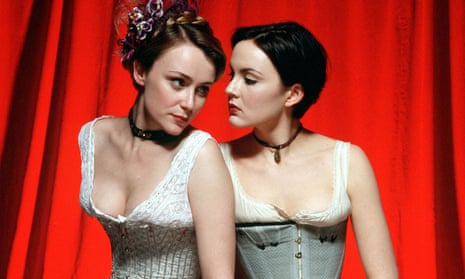“What’s it about?” people sometimes asked me, when they had heard I’d written a novel – and I always had to brace myself, slightly, to answer. There was the awkwardness of explaining the rather risque title. There was the fact that I outed myself the moment I began to reveal the plot. And then there was the plot itself – because, oh dear, how lurid it sounded, how improbable, above all how niche, the tale of a Victorian oyster girl who loses her heart to a male impersonator, becomes her partner in bed and on the music hall stage, and then, cruelly abandoned, has a spell as a cross-dressed Piccadilly prostitute and the sexual plaything of a rich older woman before finding true love and redemption with an East End socialist.
I had hoped that lesbians might like it – and was thrilled when, very quickly, helped along by word of mouth, Tipping the Velvet began to find enthusiastic gay fans. But the success of the novel among straighter readers took me by surprise. Some were drawn to it, I’m sure, as a racy curiosity. One New Zealand bookshop kept its early copies shrink-wrapped, with a “Restricted to persons aged 18 and over” sticker on them. And when, in 2002, the novel was adapted by Andrew Davies for the BBC, the story was sold to viewers, and promoted by tabloid newspapers, largely on its titillation value. But the fact that it had been adapted in the first place was a sign of how things were shifting, and Tipping’s 20-year career has coincided almost exactly with enormous changes in the lives of British lesbian and gay people, who now have equal rights with heterosexuals as partners, parents and employees, and enjoy a mainstream cultural presence I wouldn’t have believed possible back in 1998.
Actually, the novel is slightly older than 20. I wrote the first draft of it in 1995, having dreamed up the characters and plot over the previous year or so, while finishing a PhD. (I did much gleeful planning on bicycle rides to and from the Round Reading Room of the old British Library.) I remember the mid-90s as a rather electric time to be gay, and young, and living in London. There was a lot to be angry about, but also a lot to celebrate and relish. Grassroots direct action groups such as OutRage! and the Lesbian Avengers were giving lesbian and gay culture an energy and a political charge. Queer theory was beginning to have an impact on ideas about sex, gender and identity. Sh!, the “women’s erotic emporium”, had recently opened its doors in Hoxton, selling sex toys in a fun, safe space. “Were dildos OK?” we pondered, thrillingly, in my Hackney lesbian house share. Were they sexually oppressive? Might it make them more feminist if they were shaped like dolphins?

It was also an electric time to be a reader. Tipping the Velvet has sometimes been credited with having founded a new genre; in fact, lesbian and gay authors had been producing lively historical fiction for ages before I came along, and I would never have written Tipping at all if I hadn’t first been a fan of novels such as Isabel Miller’s Patience and Sarah, Ellen Galford’s Moll Cutpurse and Chris Hunt’s Street Lavender and N for Narcissus. (Nor, importantly, would those books have been available to me without the heroic gay and feminist small presses and bookshops of the era.) Inspiring, too, was the fact that ambitious gay writing was finding a place in the mainstream. I’d been gobbling up the work of Jeanette Winterson and Alan Hollinghurst alongside novels by AS Byatt, Peter Ackroyd, Toni Morrison and Angela Carter. Collectively these works, many of them with an eye on the past, seemed to show grand narratives being prised open and made to reveal – or forced to accommodate – feminist stories, queer stories, lost stories, radical stories.
I rather marvel, now, at how gamely I sat down to embark on Nancy’s story. (“I’ll give it a year, and see what happens,” I told myself – I was still young enough, at 28, to feel I had enough spare years ahead of me that I could afford to lavish one of them on a project that might go nowhere.) I researched music halls, male impersonation and the oyster trade – though “research” is rather a grand term for what was, basically, reading a handful of library books; I’m much more rigorous with the details these days. But then, Tipping the Velvet was never intended to be a work of historical realism. Instead, it offers a 1990s-flavoured lesbian Victorian London, complete with its own clubs, pubs and fashions. It conjures up an antique lesbian lingo, using, or cheerfully misusing, some of the words and phrases – “toms”, “mashers”, “tipping the velvet” itself – that I’d come across in dictionaries of historical slang and in 19th-century pornography. And it makes frequent little nods to lesbian and gay icons and classic queer texts – to Dorian Gray, Hadrian and Antinous, Woolf’s Orlando, Zola’s Nana, Compton Mackenzie’s Extraordinary Women, Henry James’s The Bostonians ... The very patchiness of lesbian history, I was trying to say, invites or incites the lesbian historical novelist to pinch, to appropriate, to make stuff up. I wanted the novel not just to reflect that, but to reflect on it, to lay bare and revel in its own artificiality.

This all sounds very high-flown, for a book that’s also a romp and a romance. And when I open it now: ouch! All I can see are its faults. Like many first novels by inexperienced authors, it is baggy and overwritten. It lays on the Victorianisms a bit thick. And Nancy the narrator, who is meant to be looking back at her younger self from somewhere in middle age, is still very much the self-regarding twentysomething whose adventures she describes – very much the self-regarding twentysomething I was when I invented her, in other words. It seemed sexy to me to make Nancy rather full of herself. Now I think she needs nothing so much as a good kick up the arse.
Still, I retain a huge affection for the book. In its very rawness, it makes me wistful. It is unafraid to be corny, unafraid to be purple; it is lavish with language in a way that now, an established author, I would be hesitant about attempting. And what fun it was to write! That’s what I remember most about it: the fun, the fizz, the exhilaration of putting it together, page by page. I owe Tipping the Velvet a great deal. Despite its flaws – because of its flaws – it made an author of me, leaving me with a hunger to write again, and write better. It got me hooked on the Victorians, which led directly to my second and third novels, Affinity and Fingersmith. And though often, when I look across my fiction as a whole, Tipping seems to me to occupy a slightly different place from the later books – as if it came from the sunny part of my brain, while the others have come, increasingly, from the darker regions – I can also see that it established a fund of tropes and tokens I’ve returned to many times: impersonation and performance, lovers and jailers, thresholds, pearls.
And it’s had some exciting afterlives. The TV adaptation found a big, mainstream audience, and gained it lots of new readers. It was recently brought to life on stage at the Lyric theatre, Hammersmith, in a rollicking version by Laura Wade. Other off-shoots, especially among the book’s core of lesbian fans, have, right from the start, been a bit wilder: I’ve had reports over the years of Tipping the Velvet-themed cocktails, club nights, parties, tattoos, pilgrimages and singles ads (“Kitty seeks Nancy”); I’ve been sent Tipping-inspired paintings, drawings, fanfic and cakes. Most movingly, many of the novel’s readers have shared poignant life stories with me; some have told me that the book helped them to come out, take courage, find partners, nurse broken hearts.
If I were writing Tipping now, what, I wonder, would I change? Well, I’d tidy it up, for starters. I would give Nancy that kick, make her less selfish and ungenerous. I might be kinder to the ghastly older ladies of Diana’s salon. I wouldn’t wheel in a black character, Bill, simply to have him be part of the white protagonist’s moral education. And I think I’d pay more attention to Nancy’s first love, Kitty. Poor Kitty: she starts off as Vesta Tilley in a shaft of rosy limelight, and ends up as a Victorian Wee Jimmy Krankie – a casualty of the novel’s 1990s take-no-prisoners out-and-proudness. But she’s a bit of a blank, and I find myself wondering now: what’s going on for Kitty? Where did she come from? What makes her tick? If I were ever to write a sequel to the novel, hers is the story I might tell.

Comments (…)
Sign in or create your Guardian account to join the discussion